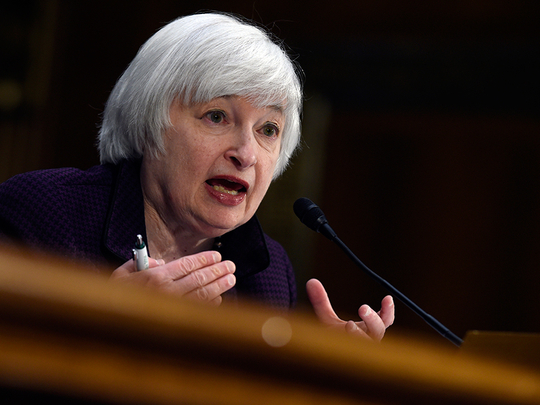
Washington: Janet Yellen wants to be less predictable, if only a little.
Should the Federal Reserve this week jettison a promise to remain “patient” about raising interest rates, as anticipated by economists, the omission will mark the end of an era in Fed communications policy and could usher in a period of greater market volatility.
Beginning in June, and for the first time since 2008, officials would be making rate decisions meeting-by-meeting, based purely on the data in front of them, rather than committing themselves to keeping borrowing costs low.
While Fed Chairwoman Yellen wants to wean investors from relying on central bank guidance on the future path of policy, she wants to avoid an excessive rise in bond yields that could sap growth.
“They want to normalise policy, and one part of normalising is to inject some uncertainty over what the central bank will do,” said Roberto Perli, a former Fed official who is now a partner in Washington for Cornerstone Macro. “Still, they don’t want the markets to go haywire.”
Almost 90 per cent of economists surveyed by Bloomberg predict officials will drop the “patient” pledge from their statement released after a two-day Federal Open Market Committee (FOMC) meeting ends on Wednesday. Some 45 per cent saw this as a step toward a June increase in rates, which have been held near zero since December 2008, according to the poll of 49 respondents conducted March 12 and 13. Thirty-seven per cent saw rate lift-off in September.
The FOMC in December dropped a longstanding pledge to keep rates near zero for a “considerable time”, saying instead that policymakers “could be patient” in deciding when to tighten.
At the press conference that followed, Yellen said the phrase meant the committee was unlikely to move rates in its next two sessions. The FOMC repeated the language in January, effectively ruling out an increase in March and April.
Removing “patient” this month will bring June into play. Yellen’s semi-annual testimony before Congress on February 24-25 signalled the Fed was getting ready to drop the phrase.
Her test, when she speaks at a press conference after this week’s meeting, will be finding the middle ground between limiting the Fed’s options and becoming entirely unpredictable.
“Yellen will emphasise until she is blue in the face she does not have to raise rates in June,” said Eric Green, head of US economic research at TD Securities US in New York, who formerly worked at the New York Fed.
Volatility is already on the rise. Measured on three-month options for two-year interest-rate swaps, a maturity that is most affected by changes in the outlook for Fed monetary policy, volatility has averaged 65 basis points this year, compared with 46 basis points in 2014.
Dropping “patient” won’t leave markets entirely without guidance. In addition to their policy statement, FOMC members this week will release their quarterly forecasts for the economy and for the future path of the benchmark federal funds rate.
Yellen and vice-chairman Stanley Fischer have also made clear they expect the pace of rate increases after lift-off will be gradual without following any prescribed timetable.
“There will continue to be plenty of signalling about the future path of policy,” said Jonathan Wright, a former Fed economist. “But there will not be explicit forward guidance that specifically ties their hands,” said Wright, now a professor at Johns Hopkins University in Baltimore.
The shift to data dependence should prove “more evolutionary than revolutionary,” according to Donald Kohn, Fed vice-chairman from 2006 to 2010. The bank is nonetheless exiting an extraordinary period in its history, he said.
“There’s been a lot more, and lot more specific, forward guidance than there ever had been,” Kohn said, now a member of the Bank of England’s Financial Policy Committee.
Central banks generally limit talk about future rate decisions because getting too specific can foster excess confidence among investors. That risks causing a market upset if the economy surprises and officials have to change course.
The traditional playbook got tossed out during the financial crisis. Not only did the Fed hit rock bottom with interest rates in December 2008, by March 2009 it began telling investors it would stay near zero for an “extended period.”
That assurance helped push down longer-term rates, providing more stimulus for the economy. Yellen, then president of the San Francisco Fed, strongly supported the wording, transcripts of the meeting show.
In August 2011, Fed officials became even more specific, saying they expected to remain on hold “at least through mid-2013.”
As the months rolled by, the Fed pushed its timeline out repeatedly. For a while, it shifted from a calendar commitment to one linked to threshold rates for unemployment and inflation, before moving to a vow to keep rates low for a “considerable time” in March 2014.
As successful as the Fed was at using forward guidance to suppress real rates, extracting itself from specific language has proved tricky.
“Forward guidance tied to the calendar is easier and more effective when you put it in, but in every case it’s taken some work to get out of it,” Kohn said.
The Fed has been very wary of triggering a repeat of the so-called taper tantrum in May 2013, when bond yields jumped after then-Chairman Ben S. Bernanke suggested the Fed might soon start to slow the pace of bond purchases. His remarks propelled 10-year Treasuries to 3 per cent by September from 1.61 per cent in early May.
As a result, each shift in the Fed’s language signalling even the slightest easing of policy has been carefully managed, to the point of comedy for some commentators.
“It’s like watching Hamlet, ‘To be, or not to be’,” said Richard Hoey, chief economist at Bank of New York Mellon Corp. “Maybe now we can have a simpler FOMC statement that we’re just going to respond rationally to economic data as it occurs.”












